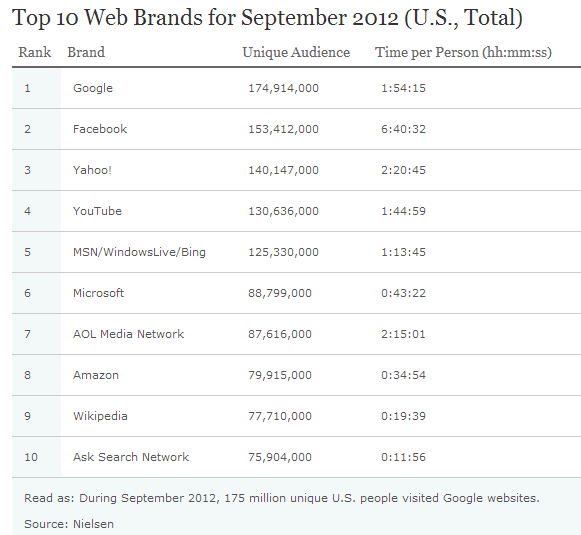Consumers rely on the internet for various reasons, and specific web properties tend to offer the most support during any given month. Sites like Google, Facebook and YouTube offer visitors invaluable sources of information, from entertainment features to educational media to social endeavors, making these sites increasingly harder to ignore. With this in mind, it’s surprising that Nielsen’s list of the Top 10 Web Brands for September 2012 show two of the three sites losing the attention of internet-users when compared to numbers recorded in March 2012.
 The report found Facebook is still the top site, with users spending an average of six hours, 40 minutes on the network in September 2012. However, this number is down by nearly a half-hour over the past six months. Even time spent on YouTube is down during the same time period, which is especially interesting, since video content is on the rise across the board.
The report found Facebook is still the top site, with users spending an average of six hours, 40 minutes on the network in September 2012. However, this number is down by nearly a half-hour over the past six months. Even time spent on YouTube is down during the same time period, which is especially interesting, since video content is on the rise across the board.
Google, on the other hand, saw an increase in how long users spent on the site during the month. While the search engine only improved its time per person metric slightly, the web portal also saw its U.S. audience increase to nearly 175 million – up 619,000 users over the past six months. Overall, Nielsen notes that the average American spent approximately 28.5 hours online in 63 sessions across channels.
In order to reach these consumers who, despite the internet becoming an integral part of daily life, aren’t spending an excessive amount of time on any one web channel, content marketing campaigns must be developed to create long-lasting impressions that encourage immediate reactions. Branded content that is tailored and written to speak to the needs of consumers can drive conversion rates, especially with the holiday season coming up, and with companies like Chase Paymentech expecting over half of their holiday sales to come from ecommerce.
Twenty-eight hours might seem like a significant amount of time to develop rapport with prospective customers, but hundreds of brands vie for the same consumers, and only the most engaging thrive. To achieve marketing objectives via content creation, marketers must speak the language of their ideal customers, and deliver media with a resounding human tone that transcends robotic web copy.




